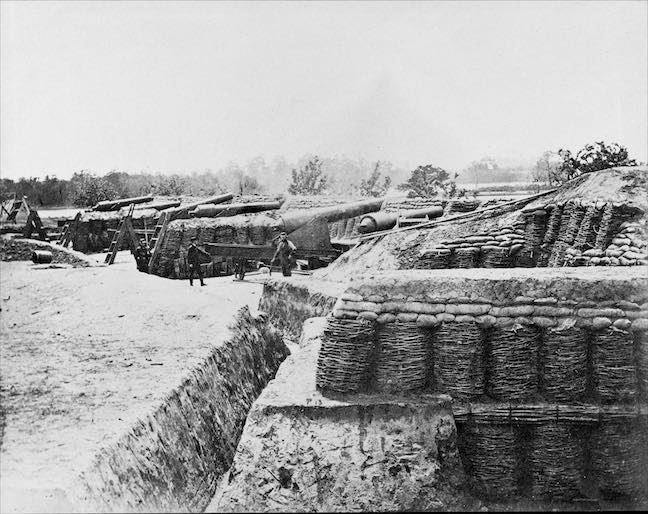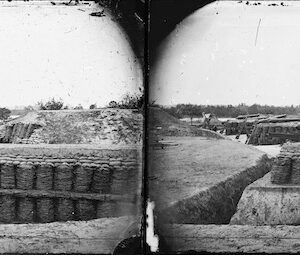| Credit: | by Wood & Gibson |
|---|---|
| Date: | 1862.05 |
| Negative Size: | 8 in. x 10 in. |
| Equipment: | Barbette carriage (front pintle-iron); cannon; gabion; handspike wrench; ladder; Parrott Rifle gun; rammer staff; sandbag; sponge staff |
| Locations & Lines: | Battery No. 1 (Yorktown VA); Yorktown VA; Virginia |
| Military Units: | 5th Corps; 5th New York Infantry; US Army |
| Persons: | Warren (Gouverneur K.) |
| Sources: | Library of Congress; National Archives |
$6.99
File Details: AIJZm, 800 DPI, TIFF, Original Photograph, 42.4 Mb
Image ID: AIJZ
Gardners Photographic Sketch Book Of The War. Vol. 1, No. 13. Battery No. 1, Near Yorktown, Va., May 1862. Battery Number One, before Yorktown, Virginia, 1862. No. 2.
This, the best constructed of all the works thrown up for the bombardment of the rebel lines, was built in the orchard of the Farinholt House, near Yorktown, and was so completely concealed behind the little crest rising from the shore of the York river, as to be quite undistinguishable from the enemys lines, except when the smoke of the guns revealed its existence. The ordnance consisted of five 100-pounders, and one of 200, all Parrot guns. The rebels, in trying to return the deadly fire of this artillery, burst one of their largest rifle guns, with fatal effect upon the cannoniers. That the fire of battery Number One contributed largely to the reasons for evacuating the stronghold, there can be no doubt, the rebels wisely reasoning that if one battery could accomplish so much, what might not be the result if all opened. This earthwork was occupied by Zouaves, Fifth Regiment New York Volunteers, commanded by Colonel, afterwards General, G. K. Warren.
While in camp at Baltimore they acquired under that officer the magnificent drill and soldierly bearing they afterwards showed upon so many battle-fields. On Federal Hill, in Baltimore, they built the strong fort of that name, this acquiring a knowledge of engineering, and, in addition to a wonderful precision in the manual and bayonet exercise, were well drilled in the use of heavy and light artillery. Attached to the division of regulars in the Fifth Corps, their record has been almost without comparison, as good and staunch soldiers. New York may well be proud of them. As a proof of their standing in the army, it was invariably their part to be chosen for an exhibition of military proficiency when distinguished visitors came to see the troops at the front. On one of these occasions they had to go through the exercised encumbered by heavy overcoats, rendered necessary by the unpresentable condition of their red breeches.
The Farinholt House Commands a fine view of the river up to Yorktown, and Gloucester opposite. With a spy-glass it was easy to overlook the rebels working upon the lines at Gloucester Point, and the fortifications on this side. Schooners, constantly coming and going, brought ammunition and stores to the wharves at Yorktown, and occasionally the battery participated, at long range, in engagements brought on by gunboats venturing too far up the river.
The oysters of York are celebrated for their excellence. In front of this house is one of the finest oyster beds in the river.

